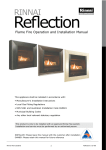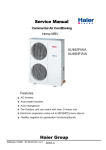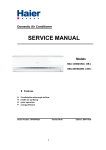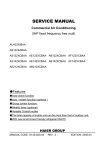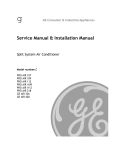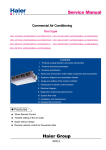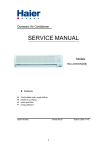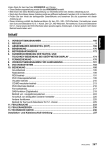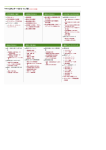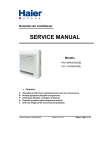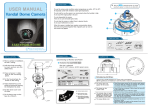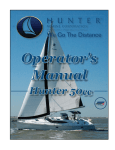Download Split Type Air Conditioner ENGINEERING DATA
Transcript
Split Type Air Conditioner ENGINEERING DATA MODELS: AS122AKAHA+AU122ACAHA(HSU-12HF03(B)) (101012884000,101012884100) AS122ALAHA+AU122ACAHA(HSU-12HH03(B)) (101012884200,101012884300) AS122AMAHA+AU122ACAHA(HSU-12HT03(B)) (101012884400,101012884500) AS122AMAIA+AU122ACAHA(HSU-12HO03(B)) (101012884400,101012884500) Content 1.Description of product model coding and series introduction------2.specifications------------------------------------------------------------------3.Curves of performance ----------------------------------------------------4.Description, dimension and function of main components and accessories ---------------------------------------------------------------5.knock-down drawings-------------------------------------------------------6.remote controller functions conversion ---------------------------------7.brief introduction to electrical control functions----------------------8.refrigerating cycle diagram----------------------------------------------9.Noise level test chart and air velocity distribution-------------------10.installation and accessory parts------------------------------------------ Description of product model coding and series instroduction 1 Description of product model coding and series instroduct Introductory Remarks A. Description of coding rules of unit model Coding rules and descriptions of new models are as follows: Indoor unit model and outdoor unit model of exported air conditioners shall be separately worked out in 10 digits combining English letters and Arabian numbers. The composition and representation are as follows: 1 2 4 3 6 5 8 7 9 10 Climate type:A,B Develop. serial no.:A,B,C Product category:A,B,D,M Appearance feature:A,B,C,D,E Product series:A,B,C,D Applicable voltage:1,2,3,4 Product specification in two digits Structural feature:S(wall-mounted),W(window type),P (cabinet type) Product type All is A AIR CONDITIONER E.g.: in , AS122AKAHA "A" represents air conditioner; "S" means wall mounted indoor unit; "12" indicates heating capacity of 12000BTU/h; "2" means applicable voltage of 220-240V/50Hz; "A" represents single split system; "K" is for appearance characteristics; "A" means heat pump type and refrigerant of R22; "H" is development serial number; "A" representsclimate type. In , AU122ACAHA "A" represents air conditioner; "U" means wall mounted outdoor unit; "12" indicates heating capacity of 12000BTU/h; "2" means applicable voltage of 220-240V/50Hz; "A" represents single split system; "C" is for appearance characteristics; "A" means heat pump type and refrigerant of R22; "H" is development serial number; "A" representsclimate type. B.Another model indentification 1 3 4 5 6 7 8 9 10 (B) Variable frequence type The type of power supply Developing sequence C-cooling only Function code H-heat pump e-electric aided heating Nominal cooling capacity (BTU/h)with the first two numbers based on thousand unit The structure code of indoor & outdoor unit H-Abbreviation of Haier Description of product model coding and series instroduct Examples: HSU-12HT03(B),It represents wall-mounted spilt type room air contioner(variable-frequency type) . The cooling capacity is 12,000BTU/h,and the power supply is 220V/50Hz . 1.Standard Situation/conditions indoor air status WB C DB C 27 19 outdoor air status WB C DB C 35 24 1 operating condition Nominal cooling 2 Nominal heating 20 ---- 7 6 3 Nominal electrical ---- ---- ---- ---- NO. C series brief introduction 1.comfortable: wide-angle airflow. The vertical dual-flap and horizontal wide-angle louvers ensure the cool (warm) air reaches every corner of the room. 2.Durable and rustproof plastic panel. Outdoor unit equipped with plastic casing is rust and corrosion-proof as well as weather-resistant. 3.Health air purifying An air purifying filter with deodorizing and disinfecting functions keep the air clean and users healthy. 4.Quiet operation Fan With Random-pitched Blades. Random-pitched blades help reduce operating noise while maintaining a high airflow rate. 5.Energy efficient The design of inner-grooved copper tube greatly increases the refrigerant contact area and the efficiency of cooling/heating functions. 6. Convenience Auto restart and washable panel: The grille can be removed easily and washed when necessary. Even if the power fails when the unit is operating, the unit will automatically return to the operating settings in use before the power failure when power is restored. 3 Description of product model coding and series instroduct Specifications SPECIFICATIONS Specification: Model: Cooling capacity: AS122AKAHA+AU122ACAHA (HSU-12HF03(B)) AS122ALAHA+AU122ACAHA (HSU-12HH03(B)) AS122AMAHA+AU122ACAHA (HSU-12HT03(B)) AS122AMAIA+AU122ACAHA (HSU-12HO03(B)) 3500(800-4300)W 2.54 Cooling coefficient: cooling Power input: Moisture removal Operating voltage range Operating temp. range Variation of temp. adjust Climate type: Heating capacity: Heating coefficient: 1380(380-1700)W 1.8X10-3m3/h 1PH, 220-230V~,50Hz -7 C-43 C O Appearance color (indoor/outdoor): O +1 C O T1 Heating power: Frequency range White/White 4800(700-5600)W 2.94 1630(400-2000)W 30-120Hz Refrigerant type R22 Air sending angle/distance 60 Fan type/quantity Class of electric shock O Cross flow fan(indoor unit) Axial fan(outdoor unit) I Indoor unit noise (cooling) 39/35/31dB(A) outdoor unit noise (cooling) 52dB(A) Indoor unit noise (heating) 40/36/32dB(A) outdoor unit noise (heating) 53dB(A) net dimensions 848 x260x315mm net dimensions 876x363X625mm Packaging dimensions (indoor unit) 863x275x330mm Packaging dimensions (outdoor unit) 891X378X640mm weight(indoor unit ) Max. mounting height difference: Refrigerant charge 7.6/10.6(net/gross)kg 5m R22 1030g Piling layers for indoor/outdoor unit 8/4 Outdoor unit net/gross weights: 34/38(net/gross) kg Current entering side (indoor/outdoor) indoor 1100g Frequency of filter cleaning Once/2 weeks Max. refrigerant charge Compressor model QXR-23C(F) Compressor manufacturer Compressor oil charge Maxi. length of connecting pipe: Cap. tube type muffle model: 320cc 10m TP2Y copper tube 1250/1085/920(indoor) 730(outdoor) Compressor protector type model of 4-way valve: Length/diameter of drain hose Max. operating pressure warm side: 2.65MPa Type/size of evaporator and condenser Max. operating pressure at cool side: cut-off valve: 1/4”,1/2” Appearance features Fan speed: (r/min) C-1RB132H22AB ------------------------2000mm/O15.6mm Internal treaded pipe O7/O12.7mm 2.65MPa Indoor unit:plastic:Outdoor unit: iron Curves of performance Curves of performance AS122AKAHA+AU122ACAHA(HSU-12HF03(B)) AS122ALAHA+AU122ACAHA(HSU-12HH03(B)) AS122AMAHA+AU122ACAHA(HSU-12HT03(B)) AS122AMAIA+AU122ACAHA(HSU-12HT03(B)) Compressor: C-1RB132H22AB A C-1RB132H22AB 3PH,60Hz,140V Condensing temp OC 40.5 Return gas temp OC 30uF/400VCA R22 Ambient temp OC B C D E 45 50 54.4 60 35 35 35 35 35 32.2 36.7 41.7 46.1 51.7 35 35 35 35 35 6.5 60.0 curent (A) 6.0 54.4 5.5 50.0 5.0 45.0 4.5 40.5 4.0 input (W) 1000 60.0 900 54.4 50.0 800 45.0 700 40.5 600 capacity (W) 5000 4000 40.5 45.0 50.0 54.4 60.0 3000 2000 1000 -10 -5 0 evaporating temp OC 5 10 Condensing temp OC 1100 Curves of performance B. curves of performance Adjust temperature range:-7OC ~ 43OC Indoor DB/WB( OC) Cooling C a p a c ity(% ) 130 120 110 100 31/22 29.2/15 29/17 25/17.5 23/16 21/14.5 19/12.5 90 80 70 In p u t(% ) 130 120 Indoor 110 DB/WB( OC) 100 70 31/22 29.2/15 29/17 25/17.5 23/16 21/14.5 60 19/12.5 90 80 20 21 25 30 35 40 45 50 Outdoor DB(OC) Heating Indoor DB(OC) C a p a c ity (% ) 130 120 110 100 90 80 70 In p u t(% ) 130 120 110 100 90 80 70 60 -5/-6 0/-2 5/3 10/7.5 20 15/12 Outdoor DB/WB( C) O 25 30 35 Description,dimension and function of main components and accessories I. NET DIMENSION FOR INDOOR UNIT NET DIMENSION FOR INDOOR UNIT NET DIMENSIONS FOR INDOOR UNIT Indoor unit MODELS:AS122AMAHA+AU122ACAHA(HSU-12HT03(B)) 182 265 795 Indoor unit MODELS:AS122ALAHA+AU122ACAHA(HSU-12HH03(B)) 265 795 182 NET DIMENSION FOR INDOOR UNIT NET DIMENSIONS FOR INDOOR UNIT Indoor unit MODELS:AS122AMAIA+AU122ACAHA(HSU-12HO03(B)) 182 265 795 Indoor unit MODELS:AS122AKAHA+AU122ACAHA(HSU-12HF03(B)) 265 795 182 II. NET DIMENSION FOR OUTDOOR UNIT NET DIMENSION FOR OUTDOOR UNIT NET DIMENSIONS FOR OUTDOOR AS122AKAHA+AU122ACAHA(HSU-12HF03(B)) AS122ALAHA+AU122ACAHA(HSU-12HH03(B)) AS122AMAHA+AU122ACAHA(HSU-12HT03(B)) AS122AMAIA+AU122ACAHA(HSU-12HO03(B)) 255 540 MODELS: 267.25 500 710 296 727 Description part and function Parts and Functions Indoor Unit AIR PURIFYING FILTER POWER PLUG INLET GRILLE MOLD PROOF AIR FILTER LOUVER The air flow direction can be adjusted with the vertical and horizontal louvers REMOTE SIGNAL RECEIVER VERTICAL LOUVER Beeping sound assures successful signal transmission between wireless remote controller and the indoor unit. HORIZONTAL LOUVER For models: AS122AMAHA (HSU-12HT03(B)) Operating Panel The test operation switch is also used as an emergency operation switch. EMERGENCY OPERATION(MANUAL)SWITCH If the wireless remote controlling device is not available ( when the wireless remote controller is lost or the battery of the controller has low charge ), the air conditioning system can be turned on temporarily. PAGE18 TEST OPERATION ( MANUAL ) SWITCH Use the test operation switch when the room temperature is below 16°C: do not use in normal operation. PAGE18 OPERATION MODE INDICATOR The opearation mode indicator lights when the air conditioner is in operation. TIMER MODE INDICATOR The timer mode indicator lights when timer switch of the remote controller is "ON" or "OFF" position. POWER INDICATOR The power indicator lights when the ON/OFF switch of remote controller is "ON". Description part and function Parts and Functions Indoor Unit AIR PURIFYING FILTER POWER PLUG INLET GRILLE MOLD PROOF AIR FILTER LOUVER REMOTE SIGNAL RECEIVER The air flow direction can be adjusted with the vertical and horizontal louvers Beeping sound assures successful signal transmission between wireless remote controller and the indoor unit. VERTICAL LOUVER For models: AS122ALAHA (HSU-12HH03(B)) HORIZONTAL LOUVER AIR PURIFYING FILTER POWER PLUG INLET GRILL MOLD PROOF AIR FILTER LOUVER REMOTE SIGNAL RECEIVER The air flow direction can be adjusted with the vertical and horizontal louvers Beeping sound assures successful signal transmission between wireless remote controller and the indoor unit. VERTICAL LOUVER For models: AS122AMAHA (HSU-12HF03(B)) HORIZONTAL LOUVER AIR PURIFYING FILTER POWER PLUG INLET GRILL MOLD PROOF AIR FILTER LOUVER REMOTE SIGNAL RECEIVER The air flow direction can be adjusted with the vertical and horizontal louvers Beeping sound assures successful signal transmission between wireless remote controller and the indoor unit. VERTICAL LOUVER For models: AS122AMAIA (HSU-12HO03(B)) HORIZONTAL LOUVER 6 Description part and function Parts and Functions Outdoor Unit KNOCK-DOWN DRAWINGS KNOCK-DOWN DRAWINGS FOR INDOOR UNIT Easily damaged NO. Name of the COMPOLENT Specialized No. QTY.components(Y/N) 1 Electric box 0010801331 1 Y 2 PCB 0010401588 1 Y 3 PCB(receiver) 001A0600287 1 4 Motor cover 001A1431372 1 Y 5 Sensor 001A3900059 1 Y 6 Tansformer 0010400633 1 7 Terminal block 001A4000095 1 ------------8 -------1 9 Front panel assy. 001A1232074 1 (1) 10 Front grille 1 11 Rear case assy. 001A0100206 1 12 Service cover 001A1431371 1 Y 13 Motor 001A3000052 1 14 Fan 001A2335028 1 15 Bearing 001A0300005 1 16 Drain pan assy. 001A0900107 1 Y 17 Swing motor 001A3000040 1 18 Flap 001A1232077 1 19 Drain hose 001A0900011 1 20 Heat exchanger 0010702567 1 001A2400060/ 21 Air filter(left/right) 1 /1 001A2400061 22 Mounting plate 001A1301216 1 23 Piping support 001A1431368 1 24 Tube nip 001A1431038 1 Y 25 Remote controller 0010401609 1 26 Drain tube 001A1434039 1 NUMBER (1) MODEL HSU-12HT03(B) HSU-12HF03(B) HSU-12HH03(B) HSU-12HO03(B) Specialized No. 001A1232075 001A1232304 001A1232303 001A0200293 21 10 9 16 18 20 26 14 15 5 25 17 11 4 24 19 7 12 2 3 8 13 6 23 22 1 KNOCK-DOWN DRAWINGS FOR INDOOR UNIT KNOCK-DOWN DRAWINGS FOR OUTDOOR UNIT 14 1 5 12 9 8 6 7 3 20 16 11 2 10 15 19 4 13 17 18 KNOCK-DOWN DRAWINGS FOR OUTDOOR UNIT Parts and Functions Parts and Functions Inserting Dry Batteries 1 Remove the lid. Gently press the part indicating OPEN, and slide the lid away from the controller. + - + + Insert the dry batteries. 3 4 Attach the lid. Verify by the indicators. If displays do not appear after a press on ON/OFF switch, set dry batteries once more. - Make sure the dry batteries are set in the right directions according to the diagram in the cavity. + 2 Note: Use two new dry batteries of the same brand and type. Remove the batteries from the controller when it is not used for a long period. When the remote controller does not work after replacement of new dry batteries, remove the dry batteries and insert them more than 30 seconds later, or press ON/OFF switch in several times without the battery inserted. Handling the Wireless Remote Controller A TE SWI NG MOD E MP ON OF F FAN TIME R POW ER/S OFT RES ET COD E LOC K When operating, point the signal sending head toward the remote signal receiver of the indoor unit. Do not allow any obstacles between the signal sending head and the signal receiver. The signal receiver may not receive the signal in a room which has an electro-lighting (rapid-start) type fluorescent lamp , an inverter-type fluorescent lamp or a cordless phone. When attaching the wireless remote controller to a wall or post, make sure that the indoor unit receives the signals. Handle the wireless remote controller with care. Do not drop, throw or wet the remote controller. Do not attach the remote controller to a place where it is exposed to direct sunlight or heat. Operation Cooling/Dry mode Operation A 1 2 Press the ON/OFF switch. 3 Adjust the designated temperature by pressing the temperature switches. Adjust the air flow speed by pressing the air flow speed switch. TEMP 3 ON 3 1 OFF SWING FAN 5 4 MODE 4 2 When the switch is set at "AUTO", the adequate air flow speed is selected by mircocomputer automatically. TIMER POWER/SOF T RESET CODE Set the operation mode to "COOL"or"DRY"by pressing the operation mode switch. OFF LOCK 5 Press the ON/OFF switch again. The system retains the previous setting conditions until next operation. NOTICE When you press the ON/OFF switch immediately after a stop, the air conditioner does not start operation for approx.3min. in order to protect the system. Then the operation will start automatically after 3min. If the system continues cooling or dry operation for a long period under high humidity, the outlet may accumulate water and cause dew drops. During dry mode operation, the system performs the cooling operation until the room temperature reaches(33.8/F) above the designated temperature. Then it continues dry mode operation intermittently with air flow speed at "LO", regardless of the designated speed. Air flow from the system may be cold when the room temperature is low. After replacing the dry batteries, the operating conditions returns to ex-factory pre-set as follows: operation mode: "COOL"; temperature: "26°C (78.8/F)"; timer mode : "NONE" ; air flow speed: "AUTO". Operation Heating Operation A 1 2 Press the ON/OFF switch. 3 Adjust the designated temperature by pressing the temperature switches. 4 Adjust the air flow speed by pressing the air flow speed switch. TEMP 3 ON 3 1 SWING OFF 5 FAN 4 MODE 2 When the switch is set at "AUTO", the microcomputer selects air flow speed automatically. TIMER POWER/SOF T RESET CODE Set the operation mode to "HEAT" by pressing the operation mode switch. OFF LOCK 5 Press the ON/OFF switch again. The system retains the previous settintg conditions until next operation. NOTICE When you press the ON/OFF switch immediately after a stop, the air conditioner does not start operation for approx.3min. in order to protect the system. Operation will start automatically after 3 min. When the room temperature has not reached the required level because of a low ambient temperature,add other heating facilities. After replacing the dry batteries, the operating conditions become ex-factory preset as follows: operation mode: "COOL"; temperature: "26°C (78.8/F)"; timer mode : "No" ; air flow speed: "AUTO". Operation Air Flow Direction Adjustment Vertical Adjustment When ON/OFF switch is pressed, the vertical louver will move to the adequate positions for each operation automatically. Swing of Air Flow If air flow direction switch is pressed once, the vertical louver will move within the range of figures as right. During Heating Operation During Cooling, Dry Operation Approx. 10 Level degrees Level Approx. 60 degrees Fixing the Flow Direction If air flow direction switch is pressed again, the vertical louver will be fixed and that position is more memorized. From the next operation the louver will be set at previous position automatically. Level Approx. 10 degrees Level Approx. 10 degrees Approx. 45 degrees Approx. 60 degrees NOTICE When the operation is off, the vertical louver closes the outlet automatically. DO NOT MOVE THE VETICAL LOUVER BY HANDS. It may make the louver not work properly. In order to move the vertical louver, use wireless remote controller without fail. In case the louver does not work correctly, once stop the operation and turn on again. During cooling or dry operation, the vertical louver should not be downward for a long time. If this is done, dew drops may appear at the outlet. (Even the louver directions is in the swing range, the louver will move about 10 degrees from horizontal after one hour.) Horizontal Adjustment Audjust the horizontal louner by moving the adjustment tabs. If the system is operated with the horizontal louver faced completely to the left or right under hign humidity (e.g. during the rainy season), dew drops may appear at the outlet. Operation Power Mode Operation Power mode operation includes super mode operation and soft mode operation. Super Mode Operation A This mode is good to have yourself blown directly to feel cooler or warmer. ON TEMP ON OFF SWING FAN Press Power Mode Switch once. The indication appears on the remote controller and the operation in Super Mode starts. During the Super Mode operarion, the air flow speed is indicated as "AUTO" on the controller. MODE TIMER POWER/SOF T RESET CODE LOCK OFF Press Power Mode Switch twice. The indication appears on the remote controller at one press and it goes out at the second press, then the operation will return to the regular operation. NOTE Unevenness of room air temperature may occur due to the intensive operation in a short time. Operation Power Mode Operation Power mode operation includes super mode operation and soft mode operation. Soft Mode Operation A Soft mode operation, operating more quietly by controlling the air flow of indoor unit, it is useful when noises should be smaller, such as, for reading and sleeping. ON TEMP ON OFF SWING FAN MODE TIMER POWER/SOF T RESET CODE LOCK Press Power Mode Switch once. The indication appears on the remote controller and the operation in Soft Mode starts. During the Soft Mode operarion, the air flow speed is indicated as "AUTO" on the controller. OFF Press Power Mode Switch twice. The indication goes out at one press, then the operation will return to the regular operation. NOTE Soft mode opertion may not be powerful enough to keep the room temperature at the designated for a long time. Operation Timer Function Usage Timer OFF Function With this function, the system stops operating after the designated period. 1 Press the ON/OFF switch Make sure that the operating conditions are those desired. A 2 OFF Set the timer mode to "OFF" by pressing the timer mode switch. Make sure that the timer mode indicator of the indoor unit lights up. H TEMP ON OFF SWING FAN 1 3 MODE The operation period can be set from 1 hour to 12 hours by an hour. TIMER 2 4 RESET Set the operation period by pressing the time setting switches. CODE 3POWER/SOF T LOCK Timer Cancellation 4 Just press the timer mode switch several times until TIMER mode disappears. Changing the Designated Period Press either or time setting switch to adjust the operating period. The timer then immediately start its function. Operation Timer Function Usage With this function, the system starts operating after the designated period: the system can be set to turn on automatically at the time of awakening or arriving home. Timer ON Function A ON H 1 Press the ON/OFF switch 2 Set the timer mode to "ON" by pressing the timer mode switch. TEMP ON 1 SWING Make sure that the timer mode indicator of the indoor unit lights up. OFF FAN 3 MODE TIMER 4 2 RESET CODE Set the operation period by pressing the time setting switches. The operation period can be set from 1 hour to 12 hour by an hour. 3 POWER/SOF T LOCK Make sure that the operating conditions are those desired. Timer Cancellation 4 Just press the timer mode switch several times until TIMER mode disappears. NOTICE Once the wireless remote controller set the timer, the period is memorized. From next time, you can operate easily with operation of the ON/OFF switch and the timer mode switch. After replacing the dry batteries, the designated period is set automatically as follows: OFF: 1 hour, ON: 6 hours.Set the timer again if necessary. If the power fails, set timer again. Power Failure Resume Function Only some of the models have this function. If the unit is started for the first time, the compressor will not start running unless 3 minutes have elapsed. When the power resumes after power failure, the unit will run automotically, the power indicator lights up, and 3 minutes later the compressor starts running with the indicator lighting up. Brief introduction to electrical function Brief introduction to electrical function Brief introduction to electrical function 1. Introduction to electrical control function Including brief introduction to air conditioners of series models and electrical control function as well as the technical information. 1.1 Brief introduction to electrical function 1.1.1 Status conversion As the following figure: Press Emergency 10-15 Unit stops Remote Control Stops Malfunction meter Press Emergency or Remote Control to stop Timer Operation Timer Trial running Cool Abnormity Diagnose Emergency Cool Sensor Abnormity Dehumidify Heat Emergency Heat 1.1.2 Automatic function (automatic running function is selected after pressing emergency button 0-5s) 1.1.2.1 Status conversion under automatic running As the following figure: Ambient Temp. Cool (setting temp. 26 ) 23 Heat (setting temp. 23 ) When running in the automatic emergency status, indoor unit can receive the remote controller’s signal to convert status. 1.1.2.2 Air volume control under automatic running Wind speed of indoor fan is automatically adjusted when automatic running, refer to air volume control under cool/heating running for details. 1.1.2.3 Frequency control for compressor under automatic running It is the same as the frequency control for compressor under cool/heating running. 1.1.2 Cooling running Brief introduction to electrical function 1.1.2.1 Air volume control under cooling running (Cool compensation temp. –0.33 ) When setting manual control, wind speed will run accord to the setting value during compressor running, and run in the speed of setting value minus 60rpm during compressor stopping. When setting automatic wind speed, its velocity is related to temperature difference compensation temp. setting temp. ). See the following table for details: Temperature difference ( ) T> 4.3 Wind speed 4.3 High T T ( 0.3 ambient temp. T < 0.3 Middle Low 1.1.2.2 Compressor control under cooling running 1.1.2.2.1 when running in normal status, control of compressor frequency: Temperature difference ( ) T> 4.3 4.3 High frequency Maximum frequency (Hz) T 1.3 Mid. frequency 1.3 T -1 T < -1 Compressor stop Low frequency 1.1.2.2.2 when running in cool mode, the setting air volume restricts frequency as follows: Setting air volume Maximum frequency (Hz) Middle 90 Hz Low 52 Hz 1.1.2.2.3 when running in cool mode, the outdoor ambient temperature restricts frequency as follows: (only applying to the machine models with outdoor ambient temperature sensor). Outdoor ambient temp. ( ) T Maximum frequency (Hz) No limitation 26 60 Hz T < 26 1.1.3 Dehumidification running 1.1.3.1 Air volume control under dehumidification running (Cool compensation temperature –0.33 ) Except for the first running that fan runs in low speed during compressor stopping, fan stops during compressor OFF. When setting manual control, wind speed runs according to the following table during compressor running: Temperature difference ( ) T Wind speed 0.3 T < 0.3 Setting Low When setting automatic wind speed, its velocity is related to temperature difference (ambient temp. setting temp.). See the following table for details: Temperature difference Wind speed ( ) T> 4.3 High 4.3 T Middle 0.3 T < 0.3 Low Brief introduction to electrical function 1.1.3.2 Compressor control under dehumidification running 1.1.3.2.1 When running in normal status, control of compressor frequency: Temperature difference ( ) Maximum frequency (Hz) 1.1.3.2.2 T 4.3 T> 4.3 High frequency T 1.3 1.3 Mid. frequency -1 T < -1 Compressor stop Low frequency When running in dehumidify mode, the setting air volume restricts frequency as follows: Setting airflow Maximum frequency (Hz) Middle 90 Hz Low 52 Hz 1.1.3.2.3 When running in dehumidify mode, the outdoor ambient temperature restricts frequency as follows: (only applying to the machine models with outdoor ambient temperature sensor). Maximum frequency (Hz) Outdoor ambient temp. ( ) T No limitation 26 60 Hz T < 26 1.1.4 Heating running (heat compensation temp. 4.67 ) 1.1.4.1 Air volume control under heating running When heating running starts, defrosting stops. When compressor restarts, it shall be warm start to prevent cold wind. Thermal conversion temperature: 35.1 (undetermined) 35.1 (undetermined) 25.2 (undetermined) 15 (undetermined) * Select higher wind speed after 4 minutes stop Lower Low setting Low Lower stop Note: For different machine type, the “undetermined” parameters is also different, here only take this example for illustration. “ * ” Indicating that if unit maintains in this wind speed for more than 4 minutes, it then select higher speed. When setting automatic wind speed, its velocity is related to the temperature difference (including compensation temperature), see the following table for details: Temperature difference ( ) Wind speed 1.1.4.2 Compressor control under heating running T> 4.3 High 4.3 T Middle 0.3 T < 0.3 Low Brief introduction to electrical function 1.1.4.2.1 When running in normal status, control of compressor frequency: Temperature difference ( ) T> 4.3 Maximum frequency (Hz) High frequency T 4.3 1.3 1.3 Mid. frequency T -1 Low frequency T < -1 Compressor stops 1.1.4.1.2 When running in dehumidify mode, the outdoor ambient temperature restricts frequency as follows: (only applying to the machine models with outdoor ambient temperature sensor). Maximum frequency (Hz) Outdoor ambient temp. ( ) T 60 Hz 15 No limitation T < 15 1.1.5 Defrosting running 1.1.5.1 Defrosting process When defrosting during heating operation, frequency is not controlled according to the temperature difference, and the maximum heating frequency is displayed. Compressor does not stop in the process of defrosting. Defrosting beginning conditions: Heat mode, the first power on operation or the lasting time to the previous defrosting finishing is more than 47 minutes, and the outdoor ambient temperature is continuously found to be less ( model: 26, 28) or -5 (model: 32, 36, 40) during compressor running, and then defrosting starts. than -4 Defrosting process as following illustration: Outdoor fan Defrosting process 4-way valve Defrosting process Compressor 55S 5S Defrosting process 55S 60S Defrosting finish compressor restart 1.1.5.2 Air volume control during defrosting 20 seconds Low wind is firstly selected during defrosting, then indoor fan stops running. 1.1.6 Special function 1.1.6.1 Trial running 1.1.6.1.1 Beginning conditions Pressing emergency button 5-10 seconds and buzzer sounding twice, then starts. 1.1.6.1.2 Running status Brief introduction to electrical function When in trial running, the display frequency of compressor is 58Hz, running mode is cool, compressor keeps on running for 30 minutes and will not be restricted by low-load protection (refer to protection function). 1.1.6.1.3 Finishing conditions Trial running will stop when remote control or emergency signal is received. After 30 minutes trial running, emergency running (automatic running) starts. 1.1.6.2 Abnormity diagnose When displaying abnormity, using indicator to express the previous error. When having no error code record, show nothing. The abnormity indicating mode will automatically disappeared 30 seconds later. The remote controller only receives stopping signal and abnormity record indicating mode will finish according to the stopping signal of the switch or the remote controller. 1.1.6.2.1 Beginning conditions Pressing emergency switch 10-15 seconds, the buzzer sounds three times, and then start. 1.1.6.2.2 Running status The indicator displays the previous error code (see the error code list). 1.1.6.2.3 Finishing condition Finishing when remote control or emergency signal is received. 1.1.7 Protection function 1.1.7.1 Low-load protection During cooling running, if the indoor coil-pipe does not evaporate thoroughly and the temperature is too low, the compressor must be stopped for protection to prevent it from damaging due to the system “liquid hitting”. See the following figure for action details: Low-load protection control: Thermal conversion temperature: 2 -0.5 Display frequency Normal Normal Min. frequency Indoor coil pipe temperature sensor type: R (25 )=10KΩ Stop Min Limit Brief introduction to electrical function During cooling-dehumidification running, low-load protection is carried out according to indoor coil-pipe temperature; whereas, the displayed frequency is “58Hz”. The minimum frequency is displayed when indoor coil- pipe temperature is lower than 2 temperature is above -0.5 . When thermal conversion temperature is lower than 0.5 and coil-pipe , selecting 3 minutes stand-by status. When indoor coil-pipe temperature is 2.1 , the compressor restarts. During trial running, the low-load protection control can be overlooked. 1.1.7.2 High-load protection During heating running, if the indoor coil-pipe temperature is too high, the compressor must be stopped for protection to prevent it from damaging due to the system overheating. See the following figure for details: Thermal conversion temperature 67 (undetermined) 62 (undetermined) 51 (undetermined) 49.2 (undetermined) 47 (undetermined) 45.2 (undetermined) Indicate frequency Stop C 3 minutes standby C B A B Stop Frequency A Parameters 80Hz Frequency B 72Hz Frequency C 50Hz Frequency D 30Hz When high-load protection is limited to act twice within 30 minutes, it is high-load protection alarm. When indoor coil pipe temperature is lower than 45 The frequency of high load protection is priority. 1.1.7.3 Compressor discharge temperature protection , it comes back to normal control. C Brief introduction to electrical function When air conditioner is running, the discharge temperature need not to be detected within the first 10 minutes and starts to detect after 10 minutes. If the detected temperature is found too high, the compressor shall be protected from damaging by decreasing frequency or stopping, see the following figure for details: 120 (undetermined) 113 (undetermined) 108 (undetermined) 80 (undetermined) release normal limit stop (3 minutes stand-by) stop restore(compressor restarts) If the compressor continuously stops twice within 30 minutes, the compressor discharge temperature protection alarms. Note: The undetermined data are for the example machine type, not for all types. The dotted line indicates the descending curve of the discharge temperature after frequency is limited, and the real line indicates the continuous ascending curve of the discharge temperature after frequency is limited. 1.1.7.4 AC over-current protection When compressor is running, overhigh current will appear if the system load is heavy. In order to reduce the current and protect the compressor, the frequency must be reduced or the compressor must be stopped, see the following for details: 7.2A (undetermined) 5.8A (undetermined) 5.1A (undetermined) normal limit reduce frequency unit stops (3 minutes stand-by) restore If continuously appears twice within 30 minutes, AC over-current protection alarms. 1.1.7.5 Over-current protection of the power module When compressor is running, if “rotation obstacle” appears or the system pressure is too high, the power module will send “over-current signal of power module” to outdoor computer board to protect it from damaging and the unit stops and alarms. 1.1.7.6 Overhigh temperature protection of the outdoor computer board Brief introduction to electrical function If the temperature of the outdoor computer board is too high, the system will reduce the frequency or stop the compressor to protect other components on the computer board from damaging, see the following figure for details: 75 (undetermined) 75 (undetermined) normal reduce frequency unit stop ( 3 minutes stand-by) restore 1.1.8 Abnormity confirmation alarm 1.1.8.1 Indoor ambient temperature sensor abnormal When in running, temperature above 126 or below -31 is abnormal. When leaving the above ranges, operation resets automatically. 1.1.8.2 Indoor coil pipe temperature sensor abnormal When in running, temperature above 196 or below -53 is abnormal. When leaving the above ranges, operation resets automatically. If abnormity appears, the low-load protection shall be released. 1.1.8.3 High-load protection Within 30 minutes after upper limit of high-load acting, the high-load protection will alarm if the upper limit of high-load acts once more. 1.1.8.4 Outdoor ambient temperature sensor abnormal Displayed as thermistor abnormity mode respectively after outdoor unit received the abnormal error code signals of defrosting, discharge temperature, control board and outdoor thermistor. Resetting operation automatically after outdoor unit received the signal of temperature sensor abnormity released. If abnormity appears, the low-load protection shall be released. 1.1.8.5 Control action of outdoor unit protection Displaying abnormity confirmation mode since outdoor unit received the following error code: Overhigh temperature protection of air discharge pipe, DC peak current, CT wiring disconnected, AC over-current, overhigh temperature protection of control board, low-voltage protection and compressor abnormal rotation. 1.1.8.6 Transmission abnormity According to the communication between indoor unit and outdoor unit, it is considered abnormal if outdoor unit cannot receive signals within 20 seconds after indoor unit’s sending. (Except for the first 2 minutes after power on). It is regarded as transmission abnormity after outdoor unit receives the signal of transmission abnormity. Transmission abnormity is released by running stopping. Brief introduction to electrical function 1.1.8.7 EEPROM When power on, EEPROM is abnormal if the control parameters and the checking total amount are not identical. EEPROM is considered abnormal since the outdoor received the abnormal signal of EEPROM. At the same time, remote control and emergency running are not accepted. It is only can be released by power blackout. 1.1.8.8 List of error code Error display Abnormity mode Powe r Time r Abnormity of indoor thermistor Abnormity of thermal conversion thermistor Abnormity of defrosting thermistor Abnormity of discharging thermistor Abnormity of control board thermistor Abnormity of module thermistor Abnormity of outdoor thermistor Run ning Indo or Outd oor * * * * * * * * * * * * * * * Transmission abnormity * Compressor running abnormity Overhigh discharging temperature protection * * AC current protection * DC current protection * Insufficient current protection Outdoor control board temperature protection Module temperature rising protection * * * High-load protection * CT wiring disconnected protection * * EEPROM abnormity Note: Autom atic restore * : Lightening : Flashing : Blackout * Indicating that this function is provided. Brief introduction to electrical function Parameter list of the main components No. Name Type Unit Indoor unit Outdoor unit 1 1 Optical coupler TLP371 Piece 1 2 Optical silicon controlled rectifier TLP3526 Piece 1 3 Rectifying bridge S15VB60 (15A 600V) Piece 4 Rectifying bridge SINB60 Piece 5 Power module TM-03 Piece 6 Relay G4A-1A DC12V (20)A Piece 7 Ceramic resonator CST10.0MTW-TF01 Piece 8 Receiver HS0038A2M Piece 2 1 1 1 1 1 1 Remarks Brief introduction to electrical function 2. Abnormity diagnose For the appeared abnormal phenomena, please refer to the following table for trouble analysis and troubleshooting: List of error code: Error display Abnormity mode Indoor Power Abnormity of indoor thermistor Abnormity of thermal conversion thermistor Abnormity of defrosting thermistor Abnormity of discharging thermistor Abnormity of control board thermistor Abnormity of module thermistor Abnormity of outdoor thermistor Transmission abnormity Timer Outdoor Running Automatic restore Possible reason * * 1. Inserter does not contact well or control board is not good. * * 1. Inserter does not contact well or control board is not good. * * 1. Inserter does not contact well or control board is not good. * * 1. Inserter does not contact well or control board is not good. * * 1. Inserter does not contact well or control board is not good. * * 1. Inserter does not contact well or control board is not good. * * 1. Inserter does not contact well or control board is not good. * * Compressor running abnormity * Overhigh discharging temperature protection * 1. There is great interference source around 2. Incorrect wire connection or control board is not good. 1. Check if compressor shaft is seized. 2. Whether power module is damaged 1. Whether system gas is insufficient or charged gas is too much. 2. Whether system voltage is too high (above242V) or too low (below 187V) 3. Whether capillary tube is blocked. 4. Whether sensors or control board components are abnormal. 5. Whether the indoor/outdoor ambient temperature is too high. Brief introduction to electrical function AC current protection 1. Whether system is charged too many gases. 2. Whether voltage is too low (below 187V). 3. Whether CT or control board component is abnormal. * Continued: DC current protection Insufficient protection current Outdoor control board temperature protection Module temperature rising protection * 1. Whether compressor shaft is seized. 2. Whether power module is damaged. 3. Whether system voltage is too high (above242V) or too low (below 187V) * 1. Whether voltage is too low. 2. Whether control board is damaged. * 1. Whether control board is abnormal. 2. Whether outdoor ambient temperature is too high. * High-load protection * CT wiring disconnected protection * * 1. Whether compressor shaft is seized. 2. Whether power module is damaged. 3. Whether heat emission glue is evenly distributed. 4. Whether system voltage is too high (above242V) or too low (below 187V) 1. Whether filter is blocked. 2. Whether the indoor/outdoor ambient temperature is too high 3. Whether system is charged too much gases. 4. Whether control board component is damaged. 5. Whether voltage is too high or too low. 1. Whether control board is damaged. 2. Whether 4-way valve is converted. 3. Whether charged gas is normal 1. Whether control board is damaged. EEPROM abnormity * Note: : Lightening : Flashing : Blackout 1. Whether control board is damaged. * Indicating that this function is provided. Abnormity diagnose Refrigerating cycle diagram Refrigerating cycle diagram indoor unit heat exchanger outdoor unit heat exchanger stop valve comp. capillary tube stop valve filter cooling operation heating operation Noise level test chart and air velocity distribution 60 60 50 50 40 40 30 30 20 20 10 10 0 0 63Hz 125Hz 250Hz 500Hz 1000Hz 2000Hz 4000Hz 8000Hz indoor outdoor dB(A) dB(A) Noise level test chart and air velocity distribution Noise level test chart and air velocity distribution Air velocity distribution uint m /s m2 Fig 1 top view flow control panel horizal lourer:center 1 2.0 0 0.5 1.0 0.25 1 2 1 3 2 4 5 6 m 7 8 9 10 uint m /s m3 2 Fig 2 top view flow control panel horizal lourer:right and left 1 0.25 0.5 1.0 0 2.0 1.0 0.5 1 0.25 2 3 0 1 3 2 5 4 6 m 7 8 3 18 2.0 1.0 0.25 0.5 1 0 1 3 2 5 4 6 m 7 3.0 9 10 Condition Fan speed:high Operation mode:fan Voltage:230V,50Hz 2.0 1.8 1.0 0.5 0 8 unitm /s m Fig 4 top view flow control panel vertical lourer:center 10 uint m /s m Fig 3 top view flow control panel horizal lourer:center 9 1 2 3 0.25 4 5 6 m Installation and accessary parts































































